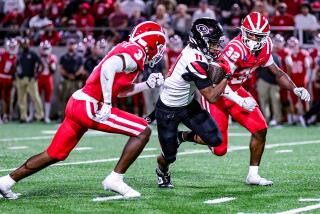Some Will Gain at Any Cost So They Won’t Lose
- Share via
These days, almost every athlete looking for an edge--any edge--eventually resorts to a change in dietary habits.
High school football players are no different. You want big? Are you sure?
Here’s where a great many of the soon-to-be big men decide to follow the lead of many prominent athletes, including tennis star Ivan Lendl.
They discover the Eat to Win diet--only with one minor difference. In their case, it’s the Eat (Everything) to Win diet.
You want to be a football hero? Just keep eating, and, oh yes, get back into that weight room.
There’s no doubt that the Eat Everything to Win diet plus lifting weights does the job. High school football players are bigger than ever. A 210-pound defensive end may have been considered huge in the ‘60s, but that same kid would probably want to run for his life if he came up against one of the 250-pound-plus players that can be found on today’s Orange County rosters.
But, with success, there is usually a price to pay. Are these athletes playing on credit--succeed now, pay with your health later?
“When they are gaining weight and working out, the muscle mass, not the body fat, increases,” said Sheila Flynn-Esquivel, a registered dietitian in the community health education department at St. Joseph Hospital in Orange.
“They need somebody who works with their diet, so they know what they’re eating. You don’t want to eat a high percentage of fat. Foods high in protein are high in fat. Most kids don’t know this.
“The problem is if they don’t get counseling. Later, when they quit, something has to give. On a diet like that, protein, high in fat, is not good for the cardiovascular system.”
The sports world gradually has accepted the idea that nutrition is a necessary part of the game plan. Professional teams are hiring dietitians.
But high school programs are not emphasizing nutrition.
Flynn-Esquivel recently spoke to a high school football team about the importance of diet.
“I could tell the coach was very ambivalent about the things I was saying,” she said. “Who is going to have a greater impact on them. Me or the coach? I felt as soon as I left, he was going to say, ‘She’s wrong, she doesn’t know what she’s talking about.’ ”
Because the phenomenon of big kids is so recent, it could be some time before there is concrete evidence about the long-term effects. At least this much is known: Big kids seem more susceptible to certain ailments.
“Some of the heavy kids have immature body makeup,” said Dr. Robert Cassidy, team doctor for Marina and Kennedy high schools. “They have repeated sprains that have kept them down. Part of that is due to their large body size, but we don’t know how much.
“When they’re bigger, there is more stress on their joints. Teen-agers have immature cartilage and bones that are still growing.”
What worries Cassidy more are the players who go beyond the usual means to achieve success. Some turn to anabolic steroids, muscle-building drugs, when the traditional ways to increase size don’t work fast enough.
The subject of steroids was a prominent topic at a meeting of the California Medical Assn. Sports Medicine Committee last week. One of the biggest obstacles is that it is nearly impossible to measure the use at the high school level.
“We don’t know whether they are going down to Mexico to get steroids or buying steroids at the local gym,” Cassidy said. “There is no way to find out. The kids aren’t going to tell you and the doctors aren’t going to tell you that they’re prescribing them to high school kids. I’m sure it’s going on.”
Cassidy said he knows of at least one Orange County football player who used steroids.
“Most of the coaches actively discourage the use,” Cassidy said. “Others don’t actively push their kids to use them, but they don’t discourage it, either. It’s sort of like looking the other way.
“If they are gaining the weight without the steroids, they probably are relatively safe. The eating and the lifting builds muscle mass. The body is capable of handling that. You can’t put on so much so fast that it becomes a significant risk. It’s when they get outside help, then it becomes a big problem.”
Strange as it may seem, it can be difficult for athletes in training to find the time to eat properly. They often resort to eating quickly, which isn’t conducive to good dietary habits.
But educating athletes when they’re still playing is only part of the answer to good health. Few players continue their football careers after high school. It’s what the athletes decide to do after their playing days that proves more crucial to their health.
“A lot of it depends on how well the kids take care of their bodies,” Cassidy said. “There isn’t as much stress with sports like swimming and biking. You don’t want to be in sports where there is pounding on the joints. It’s what people do when they finish playing that’s important.”
Said Flynn-Esquivel: “When they quit, they should have a good balanced diet. They would have to cut back on the caloric intake. Most freshmen in college gain 15 pounds. It’s not because of the food, it’s because they’re no longer as active. Their area is more restricted and they don’t move around as much.”
That’s the problem. For the last three or four years, these football players have done everything possible to gain weight. Then, when their playing careers are over, the real struggle begins.
More to Read
Get our high school sports newsletter
Prep Rally is devoted to the SoCal high school sports experience, bringing you scores, stories and a behind-the-scenes look at what makes prep sports so popular.
You may occasionally receive promotional content from the Los Angeles Times.







